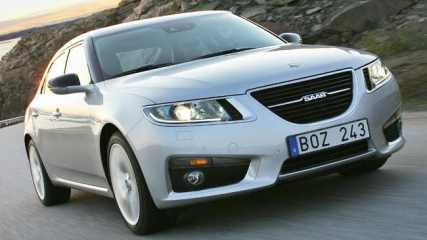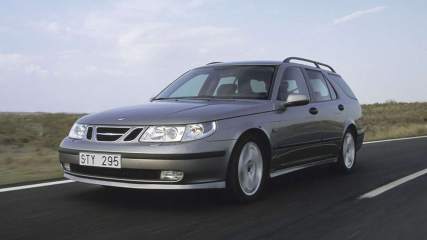Saab 9-5 2007 Review
By Stephen Corby · 31 Mar 2007
Generally, I’m in favour of trying the local delicacies in a foreign country, but a plate of hair-rings (sometimes spelled “herrings”) or some briney kippers is enough to turn anyone’s gills the colour of mushy peas.The Swedes are also very Green people, as in so environmentally aware that if they ruled the world we’d all live in flatpacked houses made out of recycled Ikea packaging and there’d be so little global warming we’d all have to wear black skivvies.Of course, we’d all have to drive Volvos or, for the slightly luckier, Saabs.Fortunately, you don’t have to wait for the meek Swedes to inherit the earth before you can use their know-how to do your bit for the planet.The Saab 9-5 BioPower is the company’s current future vision, and the best news about it is that, finally, someone has delivered a clean, green machine that doesn’t accelerate like a snail with chronic fatigue.In fact, the BioPowered 9-5 has more power and torque when it runs on ethanol than it does when chewing nasty old petrol, which pretty much makes it the great leap forward those of us who love driving and trees equally have been waiting for.The 2.0-litre turbocharged engine produces 132 kW and 280 Nm when running on E85, (a mix of 85 per cent ethanol and 15 per cent petrol). That’s up from 110 kW and 240 Nm, or a 20 per cent increase in maximum power and a 16 per cent increase in torque over the equivalent petrol model.To put that in terms teenage boys will understand, the Bio version will do 0 to 100km/h in 8.5 seconds, compared to 9.8 seconds on petrol.It should come as no surprise that the Swedes have been snapping up BioPower vehicles the way they normally Hoover up salted fish, with 12,000 sold since they were launched in July, 2005 – accounting for 80 per cent of all 9-5 sales in Saab’s home country.Obviously, it helps having ethanol widely available, but the struggle to find the stuff shouldn’t put off Australian buyers because, ingeniously, the car’s “flex-fuel’’ system means it can run - without any LPG-style flicking of switches - on any combination of E85 fuel and/or petrol.Of course, if you have to fill it up on normal unleaded, you’ll notice the lack of zip. The 9-5 we tested had the words BioPower written in 30-foot-high letters down both sides of the car (and if I had a dollar for every time someone asked me whether it ran on laundry powder, I could have bought one) so I was too embarrassed to drive it very far.But, late at night, I did do enough kilometres to note that it really did have considerable, tweaky-turbo-style get up and go.Unlike some Saabs, though, it had plenty of off-the-line grunt to match the top-end turbo rush.It’s not a sports car, by any means, but for a family sized vehicle it was a more than honest performer, with plenty of overtaking ability.The steering and dynamics didn’t seem too poor, either, but the 9-5 does fall down slightly on the interior front – which used to be a Saab strong point.Some of the fit and finish didn’t seem to be as good as we used to expect from the Swedes, and a cynic would point to the fact that the company is owned by GM these days and thus not quite master of its own destiny.The car also feels a little dated, but this could be because I can vaguely remember going to the launch of the original 9-5 in 1997 (and being forced to starve because there were only 53 types of herring on the menu), and things don’t seem to have changed much.The exterior design has at least been tweaked a little, though, and it’s undeniably a classy looking vehicle, with plenty of prestige presence and a svelte nose.So, alternative fuel issues aside, it’s not a bad car, but is turning to ethanol a worthwhile investment, or just a worthy one?The bad news is that, because it has less energy than petrol, you need to burn more ethanol to go the same distance – about 30 per cent more, according to Saab.We were seeing slightly scary figures – like 22 litres per 100km – on the trip computer. So, that loss of economy is going to take out any price advantage.On the plus side – and anyone whose seen An Inconvenient Truth will appreciate this – ethanol is a renewable and carbon-neutral fuel.This is because emissions from the exhaust pipe are balanced by the amount of CO2 that is removed from the atmosphere, through photosynthesis, when the crops that the ethanol is harvested from are grown.Saab Australia estimates that you can cut your carbon emissions by 80 per cent with a BioPower vehicle.And ethanol really can work as a fuel source. Nearly all of Brazil’s domestic road transport needs are met by bioethanol, which is produced from sugar cane.The bad news is that E85 is not readily commercially available in Australia yet, but a company called Manildra owns a number of service stations which have ethanol pumps.Despite this fact, Saab is taking orders for the BioPower vehicles, and expects to have them on sale here by June.Unlike some alternativeish cars (think the Toyota Pious), the price premium won’t be huge, with Saab Australia tipping just a $1000 to $1500 sting on top of a base 9-5, which sells for $57,900.The company is determined to take the moral high ground, with a pledge to become the country’s first carbon-neutral marque.Saab is buying a one-year ‘offset’ from Greenfleet for every one of its vehicles purchased.Under the agreement, Greenfleet will plant 17 native trees for each car sold, which will absorb the greenhouse gas emissions produced by those vehicles in one year.








